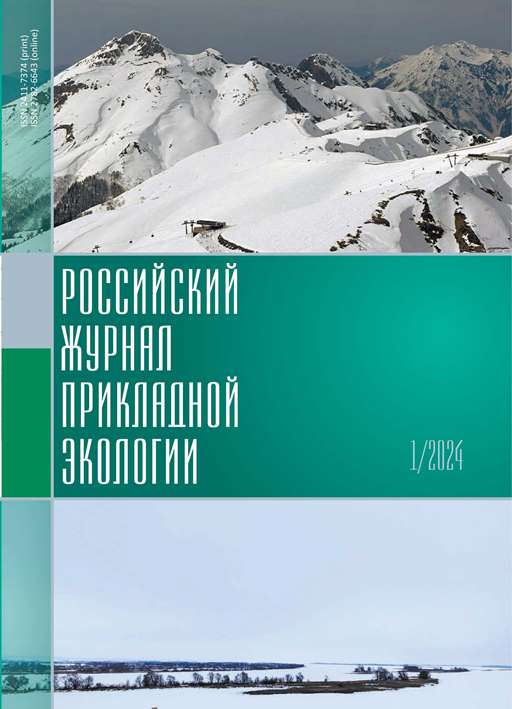Accounting the natural-anthropogenic features of hydrochemical indicators distribution when calculating specific combinatorial index of surface water pollution
DOI:
https://doi.org/10.24852/2411-7374.2024.1.39.44Keywords:
surface waters, hydrochemical indicators, substances of dual genesis, regional threshold concentrations, specific combinatorial index of water pollutionAbstract
The article substantiates the relevance of using regional threshold concentrations of potential pollutants when we record natural and anthropogenic features of hydrochemical composition of water bodies to determine the level of their pollution by the method of integrated assessment of hydrochemical indicators. The results of calculation of specific combinatorial indices of water pollution (SCIWPI) for rivers of the Republic of Tatarstan, carried out on the basis of the approved maximum permissible concentrations (MPC) of hydrochemical indicators for water bodies of fishery purpose and mathematically justified regional threshold concentrations are presented. The results of assessment of generalized indices allow to highlight manganese and sulfate ions as substances of double genesis, which have mainly natural origin. The use of their threshold values instead of MPC allows to significantly decline the contribution of these substances to the generalized pollution index. On the contrary, the contribution of such indicators as nitrates, chlorides and chemical oxygen demand increases when we use threshold values for calculating combinatorial indices. The latter can indicate the predominantly anthropogenic nature of pollution in this case
References
Belonogov V.A., Torsuev N.P. Podkhody k normirovaniyu kachestva vody na osnove mnogoletnikh nablyudenij [Approaches to water quality normalization on the basis of multi-year observations] // Sovremennaya geografiya i okruzhayushchaya sreda [Modern geography and the environment]. Kazan, 1996. P. 76‒78.
Gagarina O.V. Obzor metodov kompleksnoj ocenki kachestva poverkhnostnykh vod [Review of methods of integrated assessment of surface water quality] // Vestnik Udmurskogo universiteta. Ser.: Biologiya, nauki o Zemle [Bulletin of Udmurt University. Series: Biology, Earth Sciences]. 2005. No 11. Р. 45‒58.
Emel'yanova V.P., Danilova G.N., Kolesnikova T.Kh. Ocenka kachestva poverkhnostnykh vod sushi po gidrokhimicheskim pokazatelyam [Assessment of the quality of surface waters of the land by hydrochemical indicators] // Hydrochemical materials. Leningrad: Hydrometeoizdat, 1983. Vol. 88. Р. 119‒129.
Zamolodchikov D.G. Ocenki ehkologicheski dopustimykh urovnej antropogennogo vozdejstviya na presnovodnye ehkosistemy [Assessments of ecologically acceptable levels of anthropogenic impact on freshwater ecosystems] // Problemy ehkologicheskogo monitoringa i modelirovaniya ehkosistem [Problems of ecological monitoring and ecosystem modeling]. 1993. Vol. 15. Р. 214‒233.
Levich A.P., Bulgakov N.G., Maksimov V.N., Risnik D.V. «IN‒SITU»‒tekhnologiya ustanovleniya lokal'nykh ehkologicheskikh norm [«IN‒SITU»‒tekhnologiya ustanovleniya lokal'nykh ehkologicheskikh norm] // Issues of environmental regulation and development of a system for assessing the condition of reservoirs. Moscow, 2011. Р. 32‒57.
Musikhina T.A. Regional'nye normativy soderzhaniya khimicheskikh ehlementov v poverkhnostnykh vodakh [Regional standards for the content of chemical elements in surface waters] // Ehkologiya i promyshlennost' Rossii [Ecology and industry of Russia]. 2001. No 5. P. 26–28.
Nezhikhovskij L.A. Gidrologo-ehkologicheskie osnovy vodnogo khozyajstva [Hydrological and ecological foundations of waer management]. Leningrad: Gidrometeoizdat, 1990. 229 p.
RD 52.24.643‒2002. Metodicheskie ukazaniya. Metod kompleksnoj ocenki stepeni zagryaznennosti poverkhnostnykh vod po gidrokhimicheskim pokazatelyam. [Methodological guidelines. A method for the comprehensive assessment of the degree of contamination of surface waters by hydrochemical indicators].
Seleznyov V.A., Seleznyova A.V., Bespalova K.V. Razrabotka bassejnovykh normativov kachestva vody (na primere vodnykh ob"ektov nizhnej Volgi) [Development of basin water quality standards (using the example of water bodies of the Lower Volga)] // Vodnoe hozyajstvo Rossii [Russian water industry]. 2013. No 2. P. 42–53.
Latypova V.Z., Nikitin O.V., Stepanova N.Y., Shakirova F.M., Udachin S.A., Shagidullin R.R., Ivanov D.V., Yakovleva O.G., Mukhametshina E.G. Quality of surface waters of the Kuibyshev reservoir under conditions of different water content // Rossijskij zhurnal prikladnoj ekologii [Russian journal of applied ecology]. 2015. No 4. С. 25‒32.
Ivanov D.V. Background content of pollutants as a measure of natural environment quality normalization (review) // Rossijskij zhurnal prikladnoj ekologii [Russian journal of applied ecology]. 2021. No 4. С. 55‒66. https://doi.org/10.24852/2411-7374.2021.4.55.66.
Tunakova Yu.A., Novikova S.V., Bajbakova E.V., Valiev V.S. Metodologiya opredeleniya regional'nykh porogovykh koncentracij dlya raschyota normativov dopustimogo sbrosa zhidkikh proizvodstvennykh otkhodov v poverkhnostnye vody [Methodology for determining regional threshold concentrations for calculating standards for permissible discharge of liquid industrial waste into surface waters] // Teoreticheskaya i prikladnaya ehkologiya [Theoretical and applied ecology]. 2021. No 4. P. 28‒33. doi: 10.25750/1995-4301-2021-4-028-033.
Yanin E.P., Kuz'mich V.N., Ivanickij O.M. Regional'naya prirodnaya neodnorodnost' khimicheskogo sostava vod sushi i neobkhodimost' ee ucheta pri ocenkakh ikh ehkologicheskogo sostoyaniya i intensivnosti tekhnogennogo zagryazneniya [Regional natural heterogeneity of the chemical composition of land waters and the need to take it into account when assessing their ecological status and the intensity of man-made pollution] // Problemy okruzhayushchej sredy i prirodnykh resursov [Environmental and natural resource issues]. Moscow, 2012. Vol. 6. P. 3‒72.
Tunakova Y., Novikova S., Valiev V., Baibakova E., Novikova K. The Use of neural network modeling methods to determine regional threshold values of hydrochemical indicators in the environmental monitoring system of waterbodies // Sensors. 2023. Vol. 23. 6160. https://doi.org/10.3390/s23136160.

Downloads
Published
How to Cite
Issue
Section
License

This work is licensed under a Creative Commons Attribution-NonCommercial 4.0 International License.




